What lens resolution is needed for the Nikon D2x?
The Nikon D2x has a sensor with a density of app. 180 pixels /mm or 90 lp/mm. That is even more than a very sharp film like fuji Velvia. With this camera you want of course a output of 90 lp/mm. This can only be achieved if the lens is capable of producing at least 150-250 lp/mm. This sound strange because you should expect that a lens with 90 lp/mm is good enough.
But according to Kodak the resolution of a system is a little more complex.
The maximum resolution obtainable in practical photographic work is limited both by the camera lens and by the film. The formula often used to predict the resolution of a camera original is:
1/Rt2 = 1/Rs2 + 1/RL2 (Higgins, G.C.Appl. Opt. 3, v.1, 9, Jan 1964)
Rt = Resolution of the system (lens + sensor)
Rs = Resolution of the sensor
RL = Resolution of the lens
In practice, other external factors, such as camera movement, focus, aerial haze, etc., also decrease the resolution from the possible maximum (Ref. Kodak)
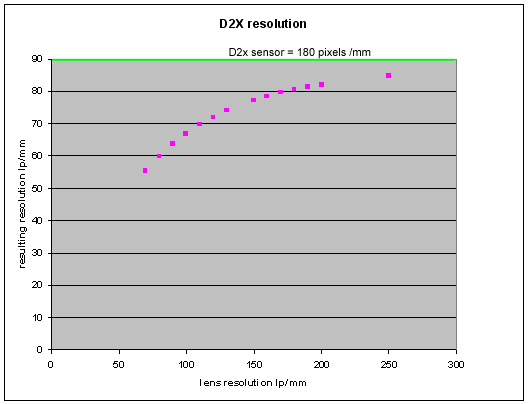
How much lp/mm can modern lenses deliver?
With a film
You can take a reference card like the well known USAF card an make a photo of it on a very sharp film. You carefully examine the negative with a 20x loupe or a microscope. Film like Kodak T-max 100 can resolve up to 120 lp/mm MTF is 50%). When a lens is tested with this method you are in fact testing the lens+film combination which will always be much lower than the real resolution of the lens. In fact you can not even reach the film resolution as indicated in the graph on the right.
When resolution is tested with this method you will get the combined resolution. When the used test film is known it is not too hard to find the lens resolution.
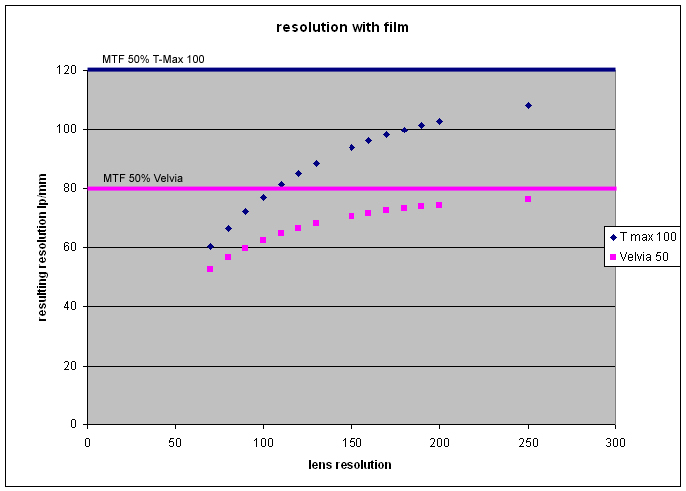
With an air image
You examine the air-image of the lens with a microscope. You now are not limited by the relatively low image of the film. Although the air image shows us the maximum resolution of the lens in question it wil say noting about the MTF. Still, an air image gives an indication of lens capabilities at certain apertures. Airial resolution can be 400 lp/mm. When tested it is limited by diffraction. Here is a table with maximum resolution depending on aperture.
Diffraction
There are many other factors which determine lens resolution. Diffraction limits the maximum resolution , it cannot be higher but it can be lower. The MTF curve affects the sharpness also. A lower resolution lens can give sharper looking images than one with higher resolution because it has better edge contrast.
Typically, such a lens will have an MTF curve which stays at relatively high values up to medium resolutions before falling off. A lens with a more gradual slope will have a higher resolution limit but may have lower contrast along edges. The eye tends to interpret edge contrast as sharpness rather than resolution.
| Aperture | Resolution lp/mm |
| 45 | 35 |
| 32 | 50 |
| 22 | 70 |
| 16 | 100 |
| 11 | 140 |
| 8 | 200 |
| 5.6 | 280 |
| 4 | 400 |
| 2.8 | 560 |
Test with Nikon 18-35 and Nikon 17-35 lens
The test i did on T-max 100 was only done to know if the 18-35 has enough potential to justify its use with the nikon D2x. The test was done only with 24mm, the same focal length as was used for the Mamiya 7 versus D2x compare. I used a testchart from Norman Koren and a USAF chart. T max 100 was developed in Xtol to minimize grain. With the T max 100 test i did a lot more effort to avoid camera shake. The tripod was made heavier with sandbags and the camera itself had a little sandbag on top of it. The 18-35 was also tested together with the Nikon 17-35 with Velvia film. In this test the 18mm and 35 mm was tested. You can also read some serious comparisons between these two lenses on these websites, David Ruether and on Camerahobby. The sites of Bjørn Rørslett. and Ken Rockwell have a wealth of lens-testing reports. They both tested the Nikon D2x.
18-35
On the negatives the 18-35 shows that this lens has a maximum resolution of about 80-90 lp/mm (centre). With Velvia the maximum is about 70 lp/mm. The calculated Airial resolution according to graph 2 is about 170 lp/mm. The aerial resolution tested with a microscope was higher. I have seen 200 lp/mm. The MTF data from Nikon shows for 10 and 30 lp/mm a nice straight curve. Even at the end of the APS sensor at 10 mm it is relatively good. The Nikon 18-35 lens shows it is a very sharp lens with a good contrast. It is maybe not the best lens for architecture , some curvation is seen, but it will certainly not disappoint you.
17-35
The 17-35 lens is very sharp although not much sharper than the 18-35 in the centre. It is a sharper with 35mm film in the border. The 17-35 was not tested with Kodak T max 100. I expect that it will give a resolution of at least 90-100. The calculated aerial resolution will be a bit higher than the 18-35. Probably 200 lp/mm. Besides sharpness it has other qualities. Meant for a different group of photographers. It is a strongly build lens. It is fast focusing and has much less problems with ghosting and flare. When you look to resolution there is probably not too much difference with the 18-35. If you compare the MTF curves you see that the 18-35 has a more straight curve than the 17-35.
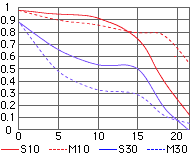
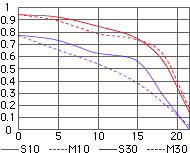
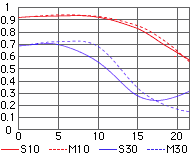
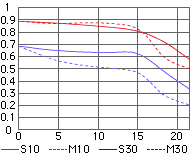
| Velvia | Velvia | Tmax100 | Tmax 100 | |
| Centre | Border (15mm) | centre | border (10mm) | |
| 18-35 18mm F8 (F11) | 70 (65) | 55 (50) | n.t. | n.t. |
| 17-35 17mm F8 (F11) | 75 (75) | 68 (61) | n.t. | n.t. |
| 18-35 24mm F8 ( F11) | n.t. | n.t. | 90 (75) | 70 (70) |
| 18-35 35mm F8 (11) | 70 (69) | 61 (61) | n.t. | n.t. |
| 17-35 35mm F8 (F11) | 68 (77) | 65 (65) | n.t. | n.t. |
n.t. = not tested.
Final conclusion
Most lens test results on the internet are obtained with the film method. The values for even good lenses are mostly lower than 100 lp/mm but even values as low as 70 lp/mm are seen for good lenses. One might think that these low values are not enough for the Nikon D2x. We must not forget that the test values published in such tests are combined values for lens+film. The test values are in fact NOT the lens resolution limits.
Happily enough it is easy to calculate the real lens resolution with the formula above or you can also use Graph [2].
With this new and probably more realistic lens resolution you can calculate what the resulting resolution will be if you use this lens on a Nikon D2x with graph [1].
As you can see in Graph [1] you will probably never reach the full potential of the D2x. With a good lens of 200 lp/mm you can reach 80+ lp/mm. In the graph you can easily see that trying to get more than 80 lp/mm will be very difficult and needs a very very sharp lens which will be very expensive.
The film test results for the Nikon 18-35 indicated that this lens is capable of 90lp/mm which results in a calculated aerial image of 200+ lp/mm. The aerial image test i did with the microscope shows also at least 200 lp/mm. so these results are comparable. That makes the 18-35 or the 17-35 suitable for use with a Nikon D2x.
APS sensor
The high density of the pixels on the APS sensor can be a problem. 90 lp/mm is difficult to obtain. High resolutions like 90 lp/mm are difficult to reach. Every part of the photomaking process must be 100%, the lens, the weather, the tripod etc. Otherwise the theoretical resolution will never be reached. Use a camera without tripod and you get half of the lp/mm you expect. A Velvia with 80lp/mm shows you only 40 lp/mm if the camera was used without a tripod. If within some time sensor density increases it will be even harder to obtain this resolution. Even with a tripod you have to lock the mirror and stabilise the camera. Even small disturbances of the photo-making will have a big impact. The question for the future will be; will a higher density give you sharper pictures in reality or do you have to use exotic tripods and lenses??
